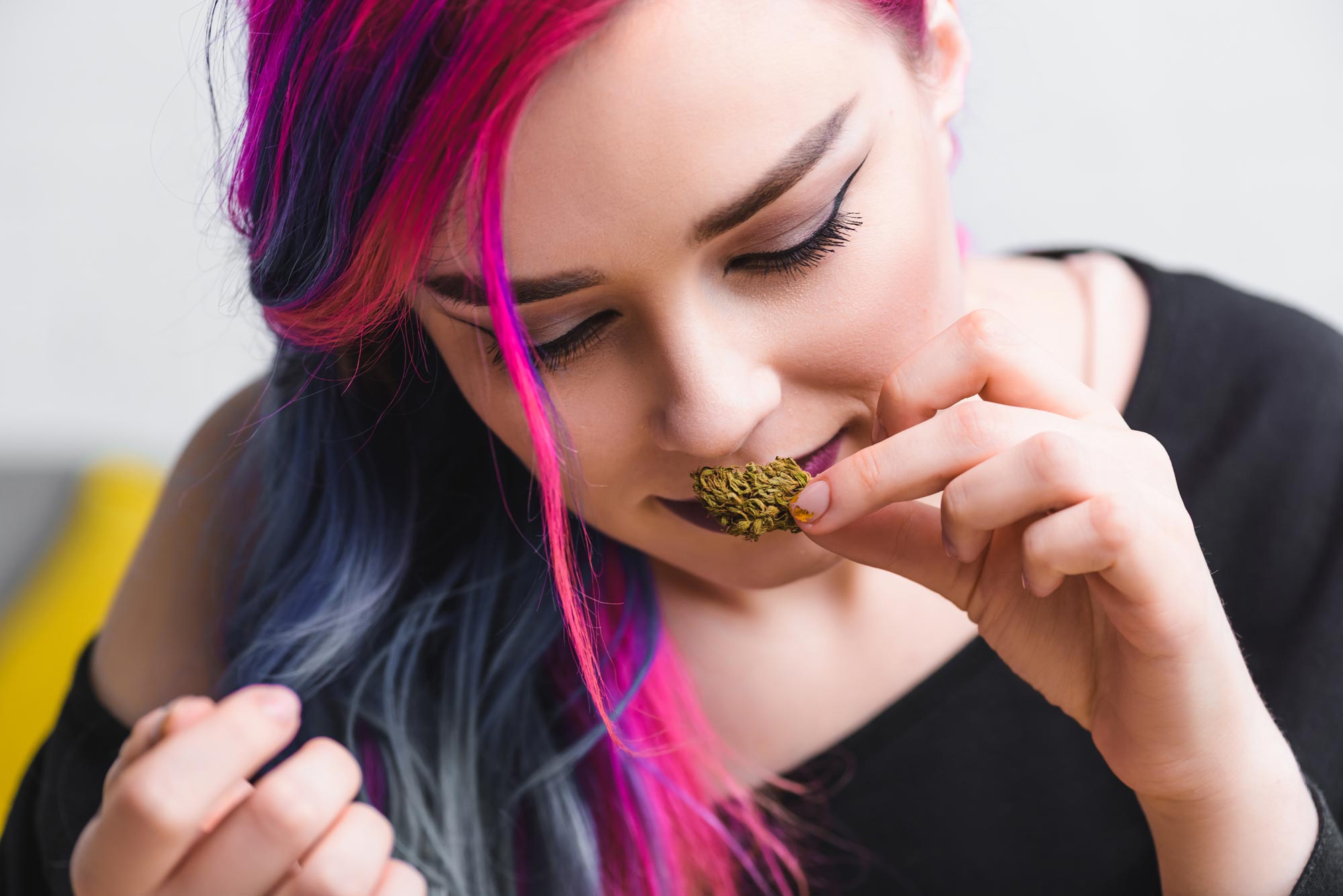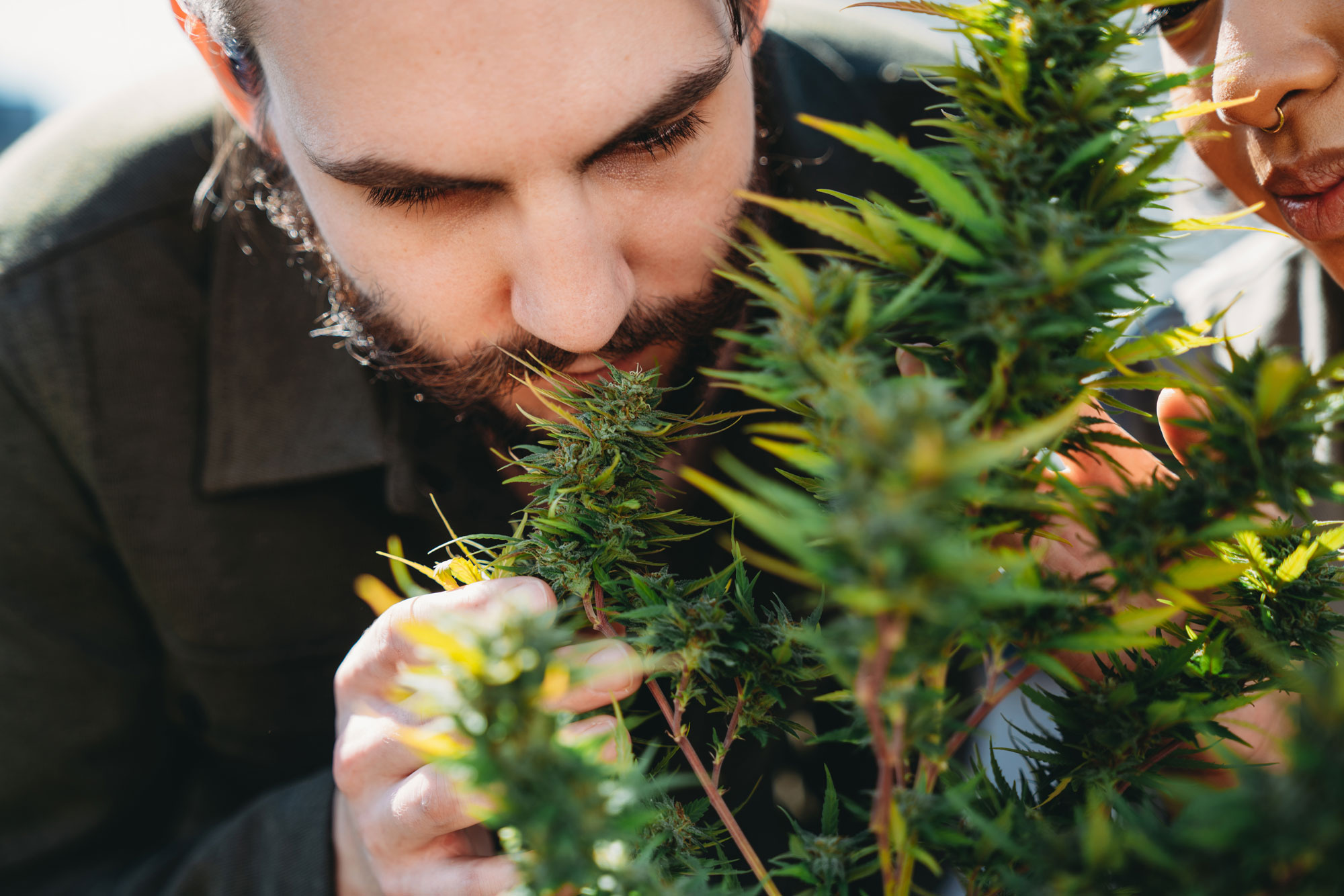Aroma More Important To Cannabis Flower Appeal Than THC: New Research
cannabisbusinesstimes.com
The debate amongst cannabis enthusiasts is ongoing: What determines ‘quality’ cannabis? Is it THC percentage? Is it the terpenes? Or is it something else?
The answer is right in front of your face: Your nose. Smell and/or aroma are the defining characteristics of ‘quality’ cannabis, according to newly published research.
The report, “The Nose Knows: Aroma, but Not THC, Mediates The Subjective Effects of Smoked and Vaporized Cannabis Flower,” was published this month in the journal Psychoactives and authored by Dr. Ethan Russo, Jeremy Plumb, Shaban Demirel, Jeremy Sackett, and Adrianne Wilson-Poe.
“Pleasant subject aroma (but not terpene expression, THC potency, or THC dose) was positively correlated with pleasant subjective effects,” the report reads. “… These results suggest that, unlike THC potency, pleasant aroma is predictive of pleasant subjective effects. Similar to other agricultural commodities such as coffee and tea, aroma appears to be a robust indicator of the quality of cannabis inflorescence.”
As the report title reads, data showed aroma or smell – not THC percentage – was the differentiating factor when determining “quality” of cannabis flower.
“The strongest contribution to subject appeal that we observed was pleasant subjective aroma. That is, cannabis flowers with the most appealing aromas were the most likely to have the greatest subjective appeal,” the report reads.
www.mdpi.com/2813-1851/1/2/8
This is a new and important first time study of aroma appeal for cannabis quality
Combined, these results provide a strong rationale for consumers to be able to smell flowers before purchasing them.
Thus, the complex aromatic makeup of cannabis inflorescence presents a complex perceptual challenge, one that is likely prone to oversimplification in the commercial context of regulated cannabis markets.
Although quantitative methods for detecting aromatic biomarkers may prove to be helpful screening tools for cannabis breeders and cultivators [89], the pleasant hedonic tone of aroma is still best characterized subjectively by humans [90,91]. In other words, quantitative methods may be helpful for identifying the aromatic constituents of cannabis, but sensory analysis is likely required to effectively evaluate what is pleasant and therefore high-quality. Aromatic features (analytes) may not always confer experiential benefits. Taken together, previous findings and our results suggest that, compared to quantified THC and terpene content, subjective aroma is a superior indicator of the quality (and therefore wholesale value) of cannabis inflorescence. This evidence may have wide-reaching impacts on the field, given that previous studies have failed to define the characteristics of “lowmid- and high-grade” cannabis [21,22].

Conclusions
With a constantly growing worldwide legal cannabis consumer base, there is a great need for consumer education about how to consume safely and responsibly. Aligned with harm reduction approaches, these blinded, unbiased results suggest that optimal recreational enjoyment may be achieved by the use of small amounts of low-potency cannabis with a pleasant aroma, particularly when used once per week or less. The results of this study may help support consumers in making evidence-based decisions that can support subjective enjoyment while decreasing health risks. The results clearly support (1) using aroma as the primary criterion in assessments of product quality, (2) regulating cannabis in a manner that allows consumers to smell flower before buying it (either in open or vented containers), (3) de-emphasizing the market value of high-THC products, and (4) diversifying regulated retail marketplaces to include a variety of inflorescence from 0.3–19% THC. These evidence-based practices would have important public health implications by minimizing THC as the primary driver of market demand and thus reducing the risks associated with THC overconsumption.
www.mybpg.com/blog/cannabis-terpenes/
thcdesign.com/blog/its-all-about-the-terpenes/
www.ncbi.nlm.nih.gov/pmc/articles/PMC7763918/
www.veriheal.com/blog/understanding-cannabis-terpe
nes-and-their-effects/
While the indica vs sativa dichotomy has been used for centuries to differentiate between cannabis strains, we now know that the cannabinoid and terpene profiles can be used to predict the effects of different strains. In “The Cannabis Sativa versus Cannabis Indica Debate: An Interview with Ethan Russo, MD,” published in the academic journal Cannabis and Cannabinoid Research, Dr. Ethan Russo argued that using indica vs sativa as a distinction between strains is not supported by cannabis science. Dr. Russo goes on to say, “it is essential that future commerce allows complete and accurate cannabinoid and terpene profiles to be available.”
trueterpenes.com/sensory/
kushfly.com/blog/cannabis-terpenes-effects-guide-terpenes-chart/
abc7news.com/cannabis-terpenes-aroma-marijuana/31
81750/
cen.acs.org/biological-chemistry/natural-products/Cannabis-industry-crafty-terpenes/97/i29
Just because two varieties of cannabis are sold under the same name, however, doesn’t mean they have the same chemical profile. Most of the time they do not.
A huge number of variables affect the terpene profile of plants, says Amber Wise, scientific director at Medicine Creek Analytics, a cannabis-testing lab in Washington State. If plants with the same genetic makeup are grown outdoors versus indoors, “you can end up with different terpene profiles at the end because temperature, growing medium, nutrients, sunlight, all kinds of things affect the terpene profile of plants,” Wise says.
https://naturalcannabis.com/the-aromas-of-cannabis/
The Aromas Of Cannabis
True cannabis lovers relish the moment of cracking open a fresh bag of buds and enjoying that first inhale. The aromas of cannabis speak directly to our brain chemistry and when specific arrangements of terpenes are a good fit for you, you’ll know it! It’s almost a compulsion to take a second or third sniff of a really great batch.
Cannabis aromas and flavors fit into several common classifications. As your knowledge and love of cannabis deepens, you can use these classifications to help you choose strains that will work best for you. Here are some of the most common aroma descriptors when it comes to describing cannabis.
Earthy: Earthy strains smell like fresh soil, a good kind of earth just overturned. These strains are often high in delta 3 carene and myrcene.
Woody: Woody strains may smell like oak, cedar or pine. They will sometimes have the aroma of sweet, freshly cut wood. Piney strains should smell fresh, like a pine forest or Christmas tree. Pine strains are high in alpha- and betapinene while other woody strains are rich terpenes like humulene, camphene, and borneol.
Gas: Gas aromas are common in strains like Sour Diesel and ChemDawg. The fragrance can range from smelling like fuel to more chemical-type smells, like cleanser or even decaying plant matter. It’s a sharp and pungent scent. Terpenes like camphene are responsible for this aroma.
Floral: Some cannabis can smell distinctly like flowers. Purple strains are often high in linalool, which is most commonly found in lavender. Other strains may smell of roses or geraniums. These strains contain terpenes like geraniol, terpineol and alpha-bisabolol.
Fruit: There are several types of fruit aromas associated with cannabis. Citrus is one of the most common. Citrus strains are high in limonene, a terpene that helps with digestion and mood. Some strains smell like rich, ripe berries while others like fresh tropical fruits. Myrcene, while often musky or earth, can also smell of red grapes or mangoes. Valencene is what gives Tangie its orange aroma.
Spice: Spicy strains can range from sharp spices like pepper and clove to herbaceous aromas like basil, mint or eucalyptus. You’ll find terpenes like sabinene, eucalyptol, caryophyllene, and terpineol in these strains.
thcdesign.com/blog/its-all-about-the-terpenes/
www.namaste.ca/blog/cannabis-terpenes/
cannigma.com/research/does-the-way-weed-smells-matter/
Why smell is a key factor
“Experienced cannabis enthusiasts always lead with the nose and there’s a good reason for that—you’re much more likely to enjoy a strain that is pleasing to your nose rather than going by only THC potency. That’s the effects of the terpenes and that’s what makes every strain of cannabis special,” Stephen Rechif, a San Francisco dispensary operator of The Bloom Room and a veteran cultivator told Leafly in 2018.
In an interview with The Cannigma in December, 2020, Maine-based physician and medical cannabis expert Dr. Dustin Sulak advised cannabis consumers to focus on the aroma, saying that when shopping for cannabis they should “take a good look at it and really smell it to get an idea of its aroma. I think people can do a great job shopping for cannabis varieties by using their nose more so than their minds and reading the names on the containers.”
In other words, while cannabis consumers often put a major emphasis on the THC content when shopping for cannabis products, they’d be better off focusing on the terpene profile of the cannabis, and whether or not the aroma is pleasing to them. This is especially true if the aroma corresponds with cannabis products that have worked for them in the past.
In the study, participants were asked to estimate the potency of a sample of cannabis, how they would pay for it and how much they want to smoke it, based solely on the aroma.
“Ratings for all three variables differed significantly across samples, indicating that a strain’s scent can impact how consumers rate these aspects of product quality,” the researchers stated.
They found that “strains in the citrus/ lemon/ sweet/pungent cluster generated higher estimates of potency, interest, and price than those in the woody/earthy/herbal cluster. Although smell-based consumer perceptions of cannabis potency vary by strain, they show no relationship to experimentally measured THC content.”
Cannabis researcher Dr. Ethan Russo told The Cannigma that when it comes to how consumers perceive the aroma of different cannabis chemovars “chances are good that people create some associations of certain odors with cannabis effects that they find desirable,” and added that “obvious examples would be citrus scents from limonene as mood elevators, and piney scents from alpha-pinene for mental clarity.”
https://www.ncbi.nlm.nih.gov/pmc/articles/PMC5798829
Our fundamental objective is to provide consumers and experts with an easily understandable set of standardized descriptive terms. Our set of 48 descriptors appears sufficient to cover the relevant odor space and allow consumers to differentiate strains by smell. The size of this set is roughly in keeping with the 85 descriptors used for coffee [8] and the 86 used for wine [7]. Nevertheless, our results also suggest that a smaller subset of odor terms may prove adequate for practical applications.
